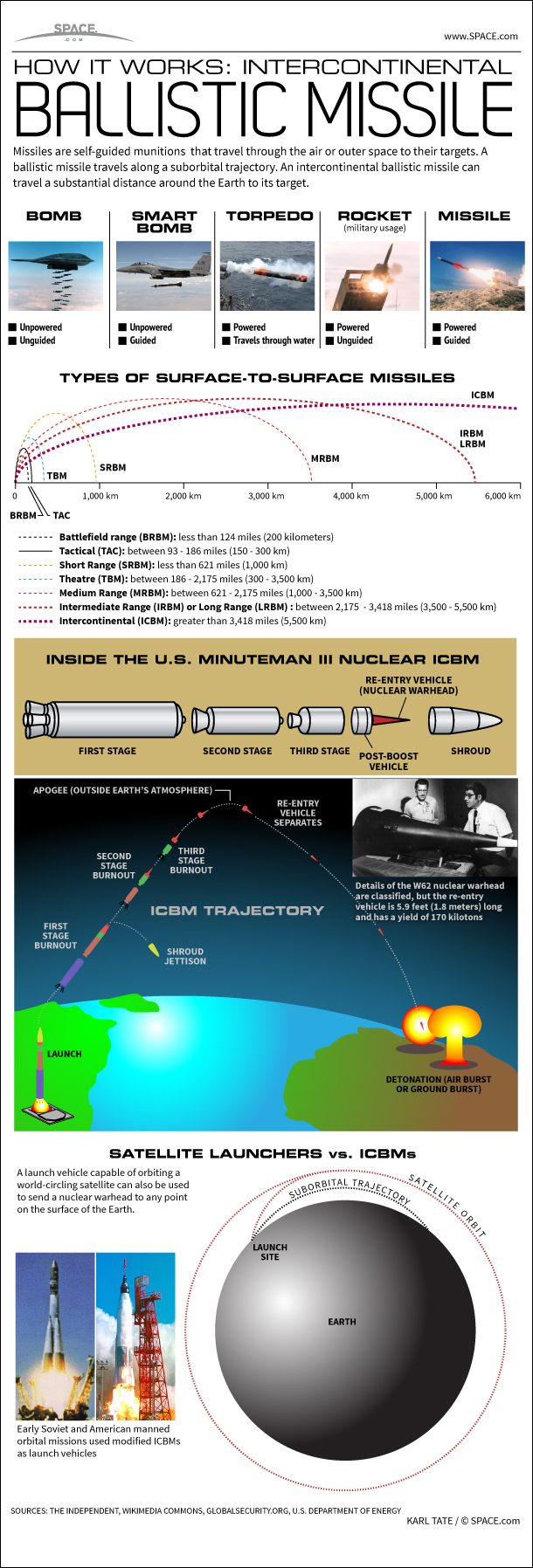House Bill Would Revive Dormant Missile Defense Kill Vehicle Project

WASHINGTON — The House Armed Services Committee wants to quickly resurrect a shelved U.S. Missile Defense Agency concept to place several miniaturized kill vehicles atop a single interceptor to address a key weakness in the current U.S. missile shield.
The multi-object kill vehicle, or MOKV, is a long-term technology the MDA would put into place after it completes work on its top priority: a redesigned kill vehicle expected to be ready around 2020, industry officials said.
Currently, the MDA's ground-based interceptors each carry a single kill vehicle designed to home in on an incoming missile warhead and destroy it by force of impact. The MOKV, by contrast, could engage several incoming objects simultaneously with kill vehicles that could communicate with one another. [How Ballistic Missiles Work (Infographic)]
One of the biggest issues with the current U.S. missile defense system is its inability to reliably distinguish between missile warheads and relatively low-tech decoys. The MOKV addresses that issue by taking out all objects deployed by an incoming missile.
In theory, the MOKV also could reduce the number of interceptors that would need to be launched to thwart a missile attack.
"Ultimately, these Multi-Object Kill Vehicles will revolutionize our missile defense architecture, substantially reducing the interceptor inventory required to defeat an evolving and more capable threat to the Homeland," Navy Vice Admiral James Syring, the director of the MDA, said in March 18 testimony to the Senate Appropriations defense subcommittee.
The MOKV concept is similar to the MDA's Multiple Kill Vehicle initiative, which U.S. President Barack Obama terminated shortly after taking office in 2009.
Breaking space news, the latest updates on rocket launches, skywatching events and more!
The White House's MDA budget request for 2016 includes funds for MOKV concept definition as part of the Common Kill Vehicle program, but does not specify how much is allocated to the effort.
The MDA is expected to award several contracts in 2016 to study the concept and begin to establish requirements, according to budget documents. The MOKV is designed "to address an emerging threat," budget documents said, without being more specific.
"We will reduce technical risk in several areas that are critical to making this revolutionary concept a reality," Syring said.
In marking up its version of the National Defense Authorization Act on April 29, the House Armed Services Committee said the MOKV should become a full-fledged development program and allocated $86 million for the effort in 2016. The MDA requested that about half that amount next year come from the Common Kill Vehicle program.
The House Armed Services Committee's mark came just a week before the U.S. Government Accountability Office issued a report criticizing the redesigned kill vehicle program.The next step for the committee-approved bill, which authorizes funding levels and sets policy direction for Department of Defense programs, is a vote on the floor of the House. [Top 10 Space Weapons]
"MDA has decided to redesign the [Ground-based Midcourse Defense] kill vehicle prior to determining whether the effort is the most cost-effective solution," the GAO said May 6 in its annual assessment of the nation's primary missile defense shield, formally known as the Ground-based Midcourse Defense system. "MDA runs the risk of starting the effort on an unsound acquisition footing and pursuing a kill vehicle that may not be the best solution to meet the warfighter's needs within cost, schedule, and technical constraints."
Other missile-defense related items in the defense authorization bill include:
Zeroing out the MDA's proposed advance procurement budget for the sea-based Standard Missile (SM)-3 Block 1B interceptor, which is used to intercept short- and medium-range ballistic missiles. The agency had requested $148 million in 2016 for a program under which it would buy more than 400 interceptors from Raytheon Missile Systems of Tuscon, Arizona, through 2019, according to government documents.
"This year, the Missile Defense Agency and DoD chose not to pursue a multi-year SM-3 Block 1B purchase, but that opportunity is being kept open for the next year," Kenyon Hiser, the SM-3 Block 1B program for Raytheon, said in a May 6 email.
Nevertheless, the Pentagon announced April 30 that the MDA would buy 44 SM-3 Block 1b missiles from Raytheon for $559 million.
Adding $30 million to the MDA's budget for an East Coast site to defend "specifically against long-range ballistic missiles from the Islamic Republic of Iran" and suggested the secretary of the Navy move the Sea-based X-band Radar to the East Coast no later than 2020.
The current Ground-based Midcourse Defense system features interceptor fields in California and Alaska, and in March 2013 the Obama administration announced plans to beef up the latter site. The MDA is studying options for a third site in the eastern half of the United States, but the Republican-led House would like to see a new field built sooner rather than later.
While Syring has said funding for the third site is not needed immediately, the House has provided money for that activity in the past.
Currently, the MDA is considering four sites: Fort Drum, New York; the Naval Air Station Portsmouth SERE Training Area, Maine; Camp Ravenna Joint Training Center, Ohio; and Fort Custer Training Center, Michigan.
This story was provided by SpaceNews, dedicated to covering all aspects of the space industry.
Mike Gruss is a veteran defense reporter and Editor-in-Chief of Sightline Media Group, which includes Army Times, Air Force Times, Dense News, Military Times and Navy Times. From 2013 to 2016, Mike served as a Senior Staff Writer for SpaceNews covering national security space programs and military space policy in the U.S. Congress. Mike earned a bachelor's degree in English and American Studies from Miami University and has previously wrote for the Journal Gazette in Fort Wayne, Indiana and the Virginian-Pilot in Virginia before joining SpaceNews. Prior to joining Sightline in 2017, he was a senior editor of FedTech magazine covering technology in federal government. You can see Mike's latest project on Twitter.


